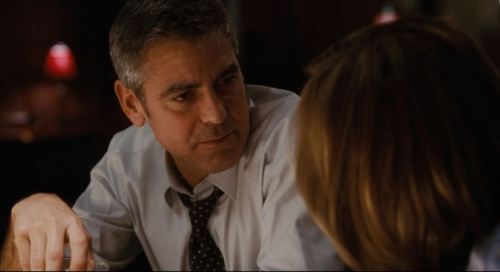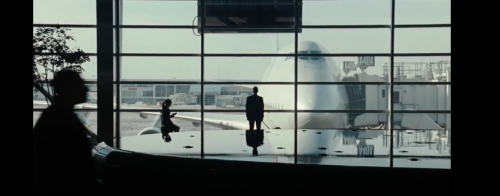Up in the Air – Review & Analysis

“Yes, it was pretty lonely.”
“Life’s better with company.”
“Yeah.”
You’ve made your bed, now go lie in it. Enter Ryan Bingham (George Clooney), a man who summarises the shifting values of the 21st century, someone you see, but never meet. Tasked with the job of firing employees for ‘weak willed’ employers, Ryan travels the nation, never rooted, always moving. George Clooney delivers one of his best performances, and stars in the ‘Clooney’ role, an aging silver fox, with a seductive combination of wit and charisma, yet tragically flawed.
In this film, a young enthusiastic new employee; Natalie Kenner, played by the adorable and remarkably short Anna Kendrick, attempts to ‘revolutionise’ Ryan’s industry by introducing technology as the method of communication. Director Jason Reitman quietly brings up the moral questions of such an industry, will Skype make an already soul crushing announcement even less human? And if so, does it justify the cheaper economic cost? For Ryan, a gamophobic, he sees this decision as a direct attack on his laissez-faire state of living, ironically forgetting about the ‘real’ victims who are actually affected by the Global Financial Crisis. Already angry at Natalie for her suggestions, Ryan is tasked with the job of introducing her to the business, giving her first hand experience in this occupation, bridging the few months wait before the technology gets implemented.
This of course, cramps Mr. Bingham’s style, who personifies ‘easy come, easy go’.
On this subtle journey of self discovery, Ryan meets Alex Goran (Vera Farmiga); the modern day film noir love interest and a perfect combination of flirtiness, wit and unreachable allure. A self described ‘road warrior’, Ryan along with the audience is hopelessly charmed by her aura, even against their better judgement. It is with these bumps in the once smooth road, that the story starts.
[INCOMING SPOILERS]

At the core of Jason Reitman’s film are the themes of relationships and responsibility; two dance partners who endlessly circle around the life of Ryan Bingham. Nothing reflects this like Ryan’s first encounter with Alex at a bar, both sipping on spirits, both waiting for the world to come and embrace them, but too jaded to make the first move. They start off their relationship by comparing credit cards, we as the audience are disgusted by such behaviour, but equally fascinated by their charm. They laugh and banter for a bit before going back to Ryan’s room to have sex. Casual and flirty; a quick transaction between two parties.
“We are two people that get turned on by elite status, I think cheap is our starting point.”
Apart from firing employees, Ryan Bingham also lectures about his isolationist philosophies, his message? “We weigh ourselves down until we can’t even move.” The core motif of this philosophy is Ryan’s travelling bag; light, compact and ruthlessly packed to maximise efficiency. The quick series of cuts showing Ryan checking into the airport at the start of the film, immediate convey his sense of character; professional, calculated and deliberate.
When Ryan’s oldest sister (Kara) calls Ryan to discuss about their young sister’s wedding (Julie), she pleads him to participate in their ‘wedding gift’. This requires him to take a few photos holding a cardboard cut out of the newly engaged couple at iconic scenes around America. Begrudging, and after a lot of resistance, Ryan agrees. From the continuation of the bag motif we can see how disgruntled Ryan is, the cardboard cut out, is a little too wide, a little too longer to fit into the metaphor of his luggage; his indifferent lifestyle of constant movement, constant activity. We start to see and understand how detached Ryan is, an emotionally damaged man, incapable, or even worse, unwilling to maintain any relationship. A man whose definition of success is to reach a mathematical number; ten millions frequent flyer miles. It all makes sense.

“How much does your life weigh? Imagine for a second that you’re carrying a backpack. I want you to feel the straps on your shoulders. Feel ’em?”
Yet this motif comes to a crescendo when Ryan sheepishly invites Alex as a date to his sister’s wedding. When asked to pin the photos of the cardboard cutouts on a map, he stands there, transfixed. In front of him is a map filled to the brim with photos from all of the couple’s friends and family, it’s so crowded that Ryan struggles to find space. And there lies the irony, this humble homely couple in Milwaukee, unable to afford a honeymoon and with close to no travel experience, has connections all over the nation. In contrast, Ryan can boast about all the exotic places he’s been, all the five star hotels he has stayed and all the casual sex he has engaged in… Yet can’t describe the feeling of friendship, he can’t describe holding someone out of a genuine sense of affection.
Ryan Bingham lived for his resume and not his eulogy.

Slowly, we can begin to see Ryan’s outlook on life change, his relationships with Alex builds and builds, overwhelming his once mathematical approach to life. Maybe, she wasn’t a burden, maybe love was more than just a transaction between two people. The wedding scene stands out as my favourite in the whole film; it was just relatable, so genuinely human. Reitman switches to a shaky cam and the tinge of vintage red makes the audience feel as if we’re attending the wedding of a close cousin. The following scene, when Ryan comes back to his unglamorous Omaha house contrasts the warmth and happiness he felt when surrounded by his new relationships. There’s no music, there’s no dancing, the world has lost its musky red filter. Only cold white walls, a vacant desk and dusty couch greet him.
During the middle of his ‘backpack’ speech in Las Vegas, a speech which was has been very excited for since the beginning of the film. Ryan stops and stutters, his philosophies have changed and the spark of superiority and sureness which glinted in his eyes previously was gone. He can’t even bring himself to say these words. He steps away from the podium, offers an apology and in an act of complete vulnerability and spontaneity, he catches a flight to Alex’s house to finally speak without his cool air of invincibility, without his sense of complete assurance.
And Ryan gets his heart crushed, Alex is married. With children.
Ryan’s whole life had been predicated upon his isolation and the distancing of himself from people. Now a middle aged man with his youth quickly fading away, Ryan realises the consequences of his actions. He made his bed, now he has to lie in it.
It’s ironic that for a man whose occupation demanded a total sense of aloofness, Ryan now stands as a victim to his own game. He hangs up on Alex after what is assumed to be their final phone call, “You are an escape… You are a break from our normal lives… You are an parenthesis.” Ryan Bingham was always very detached, unfortunately for him, he met the only person in America who was even more detached. Karma? You decide.
Dejected and demoralised, he catches a plane back home, when the announcement is made that he just hit the ten million miles mark. In celebration, the airline chief sits down beside Ryan and starts making small talk, asking him “Where are you from?” to which a disheartened Ryan can only respond with “I’m from here.”
When Ryan gets back to his office, he rings the airline company and tries to transfer his miles over to his sister and her new husband, giving them the chance to experience the honeymoon they deserve. Yet the decision is interrupted by an co-worker knocking at Ryan’s door, and he hangs up the phone. The thought is there, but whether or not he completes the action, the audience will never know.
The film ends with Ryan standing in front of a large destination board, once again called to be a ‘road warrior’. His figure dwarfed by the immensity of the screen. Stunned by the enormity of the task ahead, Ryan lets go on his luggage handle, silently protesting this lifestyle which molded him into a hermit. A man who has lived in many houses, but never a home.
And this is what separates Jason Reitman from the average director, with already a string of witty and clever films under his belt. Reitman refuses to give the audience their candy. A ‘happy ever after’ ending between Ryan and Alex would have been too smooth, too unrealistic, too impractical, and at their core, both were practical people. To have this joyous ending would have absolved Ryan and Alex from their past and ultimately, this was a film about responsibility.
You’ve made your bed, now go lie in it.
Genre: Comedy-Drama
Certificate: R
USA Release Date: 23rd December 2009
Runtime: 149 minutes
Director: Jason Reitman
Writer: Walter Kirn & Jason Reitman
Starring: George Clooney, Vera Farmiga & Anna Kendrick
Synopsis: With a job traveling around the country firing people, Ryan Bingham enjoys his life living out of a suitcase, but finds that lifestyle threatened by the presence of a new hire and a potential love interest.